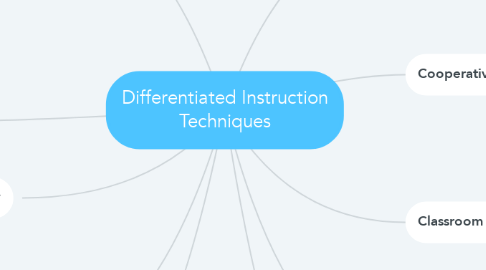
1. Questioning Techniques
1.1. Begin and end each lesson by asking questions
1.1.1. This method allows low confidence students to answer questions throughout the lesson and build up their confidence
1.1.1.1. Gives students a chance to voice their opinion
2. Individual Instructional Pedagogy
2.1. Teachers need to spend time with students individually to make sure that they are meeting their individual needs
2.1.1. Like the example in the article you can set up different learning centers for each subject to help ensure the students mastery of each lesson
3. Classroom-Based Library
3.1. Every classroom should have its own library with different genres and levels
3.1.1. For the lower level readers, teachers should make sure that they do not feel uncomfortable for reading a low level book
3.1.1.1. Location, location, location. Make sure the library is functional, cozy, and accessible
4. Technology
4.1. Students have technology at their fingertips and can use it to use educational apps
4.1.1. Applications that allow instant feedback to students are important because students can work and fix their mistakes instantly
4.1.1.1. If you have stations in your class, computers can be one of them to help students become more familiar with technology
5. Additional Classroom Staff
5.1. Paraprofessionals and special education teachers are encouraged to act as a co-teacher
5.1.1. Let students know that their work is important and that teachers are there to help them reach their goals
5.1.1.1. Principals must allow their teachers to use a multitude of differentiated instruction to ensure the students are receiving the best education
6. Instructional Strategies
6.1. The teacher has clear goals and objectives for the students
6.1.1. Content is presented through auditory, visual, tactile, and kinesthetic methods
6.1.1.1. Students should never have their heads down, but rather are engaged in learning
6.1.1.1.1. Teachers conduct observations by walking around to see if students are understanding the content
7. Cooperative Learning
7.1. Allows students the framework to show a higher level of knowledge
7.1.1. Groups normally consist of 2 to 5 kids, have an assignment for students to complete, and allows formative and summative assessments from the teacher
7.1.1.1. Teachers tend to create homogenous groups, but for it to be effective they need to be heterogeneous groupings
8. Classroom Environment
8.1. Cooperative learning should be encouraged within the classroom
8.1.1. Teachers should be able to move freely throughout the classroom, having access to each student
8.1.1.1. Display your students artwork! Let them know you are proud to show their work.
9. IEPs and 504 Plans
9.1. Principals should discuss IEPs and 504 plans with the teacher so they know which instructional strategies are within the plan
9.1.1. These plans are to be seen as a benefit because they show the teacher the students strengths and weaknesses
9.1.1.1. Have a positive and confident attitude towards these plans!
